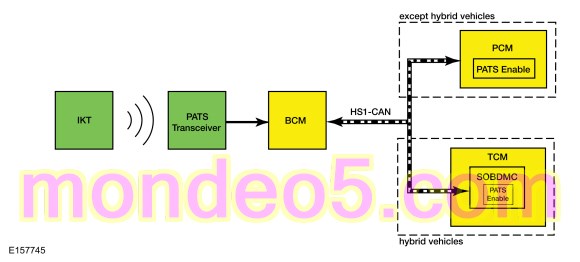| 419-01B Passive Anti-Theft System (PATS) | 2013 - 2014 Fusion |
| Description and Operation | Procedure revision date: 12/10/2012 |
System Operation
System Diagram

Network Message Chart
BCM Network Input Messages
| Broadcast Message | Originating Module | Message Purpose |
|---|---|---|
| PATS start request target data | PCM / SOBDMC | The PCM / SOBDMC sends the BCM a challenge request for a valid ID. |
PCM / SOBDMC Network Input Messages
| Broadcast Message | Originating Module | Message Purpose |
|---|---|---|
| PATS control command | BCM | The response from the BCM supplying the PCM / SOBDMC challenge ID. If the BCM ID response is incorrect, then PATS prevents the vehicle from starting. |
PATS
The PATS function is controlled by the BCM and the PCM / SOBDMC . There are 2 main checks the PATS performs before allowing the vehicle to start. These 2 checks are:
If either of these checks fail, the PATS does not allow the vehicle to start.
When the BCM determines a key is inserted into the ignition lock cylinder, it generates a challenge message. It sends the challenge message to the PATS transceiver over a LIN -based circuit. The transceiver reads the key and generates a response message to the BCM . If the message received from the PATS transceiver does not match a key stored in the BCM memory, the BCM will not respond to the PCM challenge request when the ignition transitions out of off.
The BCM activates the wake-up control circuit when a key is inserted into the ignition lock cylinder or a remote start request is received (if equipped with factory remote start).
The BCM wakes up the PCM / SOBDMC by supplying voltage on the wake-up control circuit.
Once the PCM / SOBDMC is awake, the PCM / SOBDMC sends the BCM a challenge message over the HS-CAN . When the BCM receives the challenge message, it generates a response and sends it back to the PCM / SOBDMC . If the response from the BCM does not match the data in the PCM / SOBDMC memory, this check fails and the vehicle does not start.
If both the PCM / SOBDMC identification and key verification pass, the PATS allows the vehicle to start. The PATS cannot disable or stall a vehicle that has already been activated.
PATS Parameter Identifications (PIDs)
In conjunction with Diagnostic Trouble Codes (DTCs), the PATS Parameter Identifications (PIDs) are a useful tool when diagnosing PATS concerns.
BCM PID Chart
| Acronym | Name | Description |
|---|---|---|
| KEYS_PROGMD | PATS number of ignition key codes supported | Displays the number of keys currently programmed into the BCM (if unlimited key mode is enabled, this PID only reads 2 regardless of how many keys are programmed). |
| MIN_KEYS_RQD | Minimum number of keys required | Minimum number of programmed keys required. This PID always reads 2. |
| SPAREKEY | Spare Key Programming State | Displays the customer spare key programming mode (Enabled/Disabled). When disabled, keys cannot be programmed using 2 programmed keys. |
| UNL_KEY_MODE | PATS Unlimited Key Mode | Displays the status of unlimited key mode (Enable/Disable). When disabled, a maximum of 8 keys can be programmed. |
PCM / SOBDMC PID Chart
| Acronym | Name | Description |
|---|---|---|
| PATSENABL | Vehicle enable status | Indicates if PATS allows the vehicle to be driven. Must read enabled for the vehicle to be driven. |
Component Description
Integrated Keyhead Transmitter (IKT)
The Integrated Keyhead Transmitter (IKT) incorporates both the PATS functions and the RKE transmitter functions in a single device.
During key programming procedures, the PATS and the RKE transmitter of an Integrated Keyhead Transmitter (IKT) are programmed into the BCM . Conventional PATS keys can also be programmed to the vehicle if requested by the customer.
A minimum of 2 and a maximum of 8 keys can be programmed (unless in unlimited key mode).
PATS Transceiver
The PATS transceiver reads any key placed in the ignition lock cylinder. When the ignition changes to RUN or START, the BCM activates the PATS transceiver. Once the PATS transceiver activates, it activates the key in the ignition and receives the key data. Once the PATS transceiver receives the key data, it sends the data to the BCM .
BCM
When the BCM is replaced, program at least 2 keys and perform the parameter reset procedure.
PCM / SOBDMC
When the PCM / SOBDMC is replaced, perform the parameter reset procedure. There is no need to program keys if the PCM / SOBDMC is replaced.
Copyright © Ford Motor Company